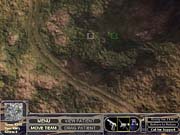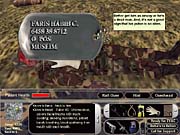Legacy Interactive's Combat Medic: Special Ops is basically a cross between an action game and a puzzle game. You play as a modern-day combat medic engaged in a war in the Middle East, and you occasionally play through top-down action sequences in which you shoot at enemy soldiers, though you spend the majority of the game operating on wounded soldiers using a puzzle-game interface. It's an unusual idea, and certainly an interesting one, but as you play, you'll find that Combat Medic probably wasn't the best idea for a game.

Combat Medic basically has two parts: an action part and a puzzle part. The action part makes up a relatively small percentage of the game, and in it, you control your tiny combat medic from a top-down perspective as he runs about the battlefield shooting at enemy soldiers and looking for wounded allied troops. This part of the game isn't exciting or fast-paced, since aiming at your enemies is as easy as pointing and clicking on them until they stop moving, which they usually do quickly. It's not particularly attractive either, since these action sequences take place between crude stick-figure representations of soldiers on extremely pixelated battlefields. The sound effects for the various weapons and radio communications are adequate, but they don't really make the action sequences any more interesting. When you find an injured patient, you can switch to the patient screen. Once there, you can quickly switch to and from the action screen, which you may have to do if you're taking fire.
You'll spend most of your time in Combat Medic in the patient screen, treating wounded soldiers, whom you'll find lying scattered about the action maps. As soon as you begin treating a soldier, the game's perspective switches to a close-up view of a blocky, stiffly animated 3D soldier who may be suffering from a number of different conditions, ranging from shell shock to broken limbs to life-or-death trauma. Depending on your patient's condition, he may insist that you let him get back into battle, moan in pain and fear, or be completely delirious--the voice acting is delivered convincingly, but there are only a few voice samples, and you'll soon hear them repeated. You treat each soldier using the tools in your backpack, all of which are authentic US Army medical tools, including nasal and tracheal breathing tubes, splints and cravats, and syringes filled with various painkillers. Essentially, it's a puzzle matching game. You must assess each patient's condition, and then perform the corresponding operation. For instance, if your patient has suffered a broken leg, you'll need to dress any wounds and put the leg in a splint. If your patient has had his midsection blown open, you'll need to bandage the blocky pink polygons sticking out of his stomach (his intestines) and give him some morphine for the pain. Despite the relatively crude graphics, Combat Medic's depiction of injuries is pretty graphic. Wounded soldiers are covered with blood, and you'll even be able to amputate limbs that can't be saved.
The game has a helpful hint system that will basically tell you what tool to use next on which body part. Whether you use the hints or not, you'll probably find the game's interface to be at least a little frustrating. The only way to cycle through the tools in your backpack is to move your mouse cursor over the left or right arrow icons onscreen, and the movement between your different instruments is sluggish. In addition, you have to be very precise about where you click on your patient's body. In order to target your patient's hand to take his pulse, for instance, you'll need to move the cursor to just the right position on his hand. Otherwise, the procedure won't work.

You might think that Combat Medic is just a game with a bad interface and a poor control scheme, and leave it at that. But if you think about it, the game's slow-to-navigate medical kit and overly precise requirements for targeting your patients' body parts are actually a pretty good representation of what it's like to operate on a real battlefield, at least in theory. Waiting for the game's medkit to sluggishly scroll to the proper tool seems a bit like fumbling with a real-world medkit for just the right tool to treat a wounded, bleeding soldier. And having to be extremely precise when applying your tools to your patient's body parts also makes sense, since field operations on tense, frightened soldiers under heavy fire also requires extreme precision and skill.
Unfortunately, these real-world correlations don't really change the fact that Combat Medic, which is a computer game, has a clumsy interface and an unresponsive control scheme. In other words, although the game's patient-treatment parts may actually help convey, in a limited and very abstract sense, what it's like to be a field medic, they don't make for a very good game. Considering its graphic depiction of injuries, Combat Medic is clearly unsuitable as an educational tool for children, and considering its weak action sequences, it doesn't really seem like much of a game for action game fans either. The fact that Combat Medic's music is very subdued and very forgettable also doesn't help, and once you finish the game's 10 missions, you won't have much incentive to replay the game. (Setting the game on a higher difficulty level gives you less time to save your patients and adds more enemy soldiers, but that's about it.) If you'd really like to get some idea of what it's like to be a real-life army medic, and you don't mind doing so in an abstract way that isn't all that realistic, you might enjoy Combat Medic. Otherwise, you probably won't.